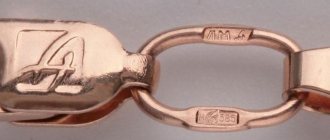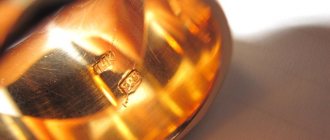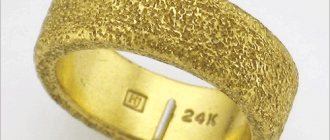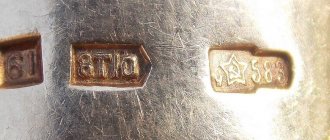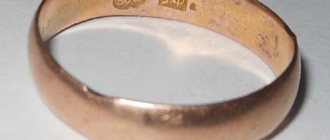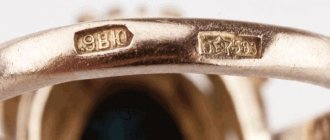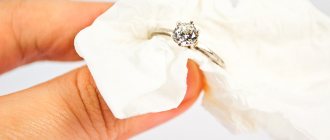An important point to pay attention to when buying jewelry is the hallmark on the gold. This mark is a confirmation of the quality of the jewelry and the content of precious metal in it in a certain amount. In Russia, the first such marks were placed on gold items already in the 17th century. By decree of Peter the Great, samples for precious metals were introduced at the legislative level.
The meaning of the mark
Modern products made of precious metals must comply with accepted standards. This is confirmed by the corresponding mark on the product. Depending on the content of gold, copper, silver and other metals in the alloy, they range from 375 to 999 samples. Dental prostheses are made from an alloy with a purity of 375 (it contains 38% precious metal). Jewelry is made from metal of 500, 585 and 750 samples. The purest gold of 999 purity is used only for the production of bank bars. This metal is significantly more expensive than alloys.
To indicate the amount of precious metal, an imprint is made on the jewelry with the corresponding numbers. For example, the mark on 585 gold is affixed in the form of this number. Products manufactured in other countries may have their own system for determining the purity of the alloy (measured in carats). The jewelry is also affixed with the personal mark of the jeweler or manufacturer - the name.
How to determine gold purity by the color of the alloy
The color of pure gold is bright yellow, but due to its softness, this metal in its pure form is not used to create jewelry. Jewelry is made from gold alloys, in which only part of the composition is allocated to gold. Ligatures (additives) make the connection harder, stronger, and give it different shades.
Based on the shade of the alloy from which the product is made, one can assume its sample. But this method of determining the composition is imperfect; only examination can accurately determine the percentage of gold and other metals.
Pink
This shade is characteristic of alloys containing silver and copper, in particular the following samples:
- 375: dark pink,
- 585: soft pink;
- 750: slightly pinkish.
White
If you see a piece of jewelry with a white tint, most likely it is 750-grade metal. 25% of the composition is occupied by silver and palladium or silver and nickel.
Green
- Dark green color is typical for 750 standard with the following composition: 75% gold, 15% silver, 6% copper, 4% cadmium.
- The pale green material is obtained when 23% copper and 2% cadmium are added to 75% gold.
- The yellow-green metal is most likely 750 fine, and 25% of the composition is silver.
Violet
Gold jewelry may have a purple tint if it is made from a 14-karat alloy that contains 25% aluminum or potassium. If the color is rather bluish, then with a high probability it is a composition of 46% noble metal and 54% rhodium, cobalt or indium.
Sources
- https://lombardyinfo.ru/stati/probirnoe-klejmo.html
- https://ZolotoMan.ru/proby/klejmo-na-zolote.html
- https://ToZoloto.ru/proba/klejmo-na-zolote.html
- https://zolotogid.ru/metally/sistema-oboznacheniya-proby-na-zolotyh-izdeliyah-i-pozolote/
- https://uvelir.info/articles/probirovanie-yuvelirnyih-izdelij-eto-dolzhen-znat-kazhdyij-probyi-klejma-imenniki/
- https://goldomania.ru/articles-2/hallmark_gold.html
- https://russam.ru/stati/o_juvelirnyh_izdelijah/p18881-kakie_byvajut_proby_zolota/
Location and appearance
Where jewelry is marked depends on the type of jewelry. But regardless of the location of the sign, manufacturers try to make it inconspicuous. To find it, it is better to use a lens. Most often the mark is located in the following places:
- On a ring - inside or outside the rim.
- On earrings - on earrings or pins.
- On pendants or pendants - on special rings for hanging.
- On the bracelet - between the product and the lock.
The mark that is issued by the controlling body - the state assay office - consists of 2 contours of a rectangular, oval or oblong shape (for gold). Inside you can see the profile of a girl in a kokoshnik facing to the right, the inspection code and numbers indicating the sample. If we are talking about items made in the USSR, the gold hallmark looks like a five-pointed star.
For other precious metals, signs in the form of other figures are provided. The code shows which territorial inspection carried out the inspection and stamped the jewelry. For each division there is a strict arrangement of elements. For example, the Central Inspectorate (CIPN) marks gold products with the letter M in the lower left corner of the hallmark or a dot in its upper right corner.
Classification of testing types
There are three main gold assay systems in the world:
- metric;
- carat;
- spool valve
For the spool test, the Russian pound was taken as a basis, which consisted of 96 spools. Accordingly, the highest sample and the starting point was 96 samples. This measurement system also included such samples as: 92, 82, 72, 56. It operated in Russia until 1927 and is not currently used.
The karate scoring system is more common in Europe and originates in Germany. The weight of one carat is 9.7 grams. gold. The starting point and indicator of the highest gold content is the 24th sample. There are also samples such as: 22, 18, 14 and 9.
The metric testing system is the most common and understandable. The stamp displays numbers that show the amount of pure gold in a kilogram of the alloy. The stamp also depicts a letter that denotes the code of the state inspection inspection for trial supervision. Each assay office has its own and it can be used to determine who carried out the research. In addition to the numbers indicating the amount of gold, the sample depicts a symbol with a hammer and sickle against the background of a star or a newer one, in the form of a girl’s head in a traditional headdress. This system has been in use since 1994.
Correlation of sample values in different sampling systems
| Metric | Carat | Zolotnikovaya |
| 999 | 24 | 96 |
| 958 | 23 | 92 |
| 750 | 18 | 72 |
| 585 | 14 | 56 |
The following samples are used for silver: 750, 800, 875, 916 and 925.
On platinum you can find a mark marked 850, 900 or 950.
Palladium can be 500 or 850 fine.
Specifics of the name
Name tag is a mark that contains information about the manufacturer . The data is encrypted with 4 Russian letters:
- The first letter is the year of manufacture (A - 2001, B - 2002, etc.). The letters Е, Ж, И are not used when applying markings.
- The second is the inspection body.
- The third and fourth are the manufacturer's code.
- If there is a P next to the letters, the product has been restored.
The outline of the nameplate should not contain any other designations - for example, copyright protection or the manufacturer's trademark.
The hallmark stamp on the ring is usually placed to the right of the name mark. All names of manufacturers must be registered with the territorial assay supervision authorities. The contour is determined independently by the territorial assay office. Its form must be the same for all enterprises that operate in the territory of the GIPN and are subject to control by it. For the spark method of imprinting, the characteristic features will be vertical lines between the outline and the letters, as well as a horizontal line in the upper front part.
MARKING OF JEWELRY.
State Assay Supervision Inspectorate
supervises the compliance of jewelry manufactured in Russia and imported from abroad for sale. Performs an examination of museum and archival values from DM and DK, and carries out periodic monitoring to ensure the safety of these values.
- The inspectorate produces assay reagents on orders from legal entities and entrepreneurs.
- Carries out periodic monitoring of the completeness of collection and delivery to the state. fund of drag-containing waste.
- Registers codes of names of jewelry manufacturers.
- Registers legal entities and individual entrepreneurs (special registration).
- Exercises state control over the import and export of DM and DC to and from Russia.
- Financial monitoring (control over transactions with DM and DC in the amount of 600,000 rubles and above.
- Provides assay supervision over the activities of facilities where DM and DC are used.
| Inspection code | Name of inspection | Inspection address | Areas of operation |
| IN | Verkhne-Volzhskaya | 157940, urban settlement Krasnoe-on-Volga, Kostroma region, Krasnaya sq., no. 7 | Ivanovo, Kostroma, Yaroslavl regions |
| G | Volgo-Vyatka | 603006, Nizhny Novgorod, st. Gruzinskaya, 41 b | Republic of Mordovia, Republic of Mari El, Republic of Tatarstan (Tatarstan), Chuvash Republic - Chuvashia, Vladimir, Kirov and Nizhny Novgorod regions |
| I | East Siberian | 660041, Krasnoyarsk, Svobodny Ave., 72 | Republic of Tyva, Republic of Khakassia, Krasnoyarsk Territory, Irkutsk Region, Ust-Orda Buryat, Evenki, Taimyr (Dolgano-Nenets) Autonomous Okrugs |
| YU | Far Eastern | 680009, Khabarovsk, st. Promyshlennaya, 20 v | Primorsky and Khabarovsk territories, Amur, Kamchatka, Magadan, Sakhalin regions, Koryak and Chukotka autonomous districts, Jewish Autonomous Region |
| TO | Donskaya | 344018, Rostov-on-Don, Budennovsky Prospekt, 104/91 | Republic of Adygea (Adygea), Kabardino-Balkarian Republic, Karachay-Cherkess Republic, Republic of North Ossetia-Alania, Chechen Republic, Krasnodar and Stavropol Territories, Rostov Region |
| AND | Zabaikalskaya | 670031, Buryatia, Ulan-Ude, st. Tereshkova, 9 | Republic of Buryatia, Chita region, Aginsky Buryat Autonomous Okrug |
| F | Western | 236022, Kaliningrad, Gvardeisky Prospekt, 15, PO Box 473 | Kaliningrad region |
| N | West Siberian | 630027, Novosibirsk city, st. Taiginskaya, 17 / 1 | Altai Republic, Altai Territory, Kemerovo, Novosibirsk, Omsk and Tomsk regions |
| ABOUT | Orlovskaya | 302028, Orel, st. Oktyabrskaya, 27 | Belgorod, Kursk, Lipetsk and Oryol regions |
| P | Povolzhskaya | 450076, Bashkortostan, Ufa, st. Zentsova, 47 | Republic of Bashkortostan, Orenburg and Ulyanovsk regions |
| B | Podmoskovnaya (disbanded) | 140170, Bronnitsy Moscow region, lane Komsomolsky, 537 | Moscow region (Voskresensky, Domodedovo, Egorievsky, Zaraisky, Kashirsky, Kolomensky, Lukhovitsky, Lyuberetsky*, Noginsky, Ozersky, Orekhovo-Zuevsky, Pavlovo-Posadsky, Podolsky, Ramensky, Serebryano-Prudsky, Serpukhovsky, Stupinsky, Chekhovsky, Shatura districts), Ryazan and Tambov regions * With the exception of OJSC "Moscow Production Association for the Production of Diamond Tools" (MPO for VAI) |
| Z | Caspian | 367026, Republic of Dagestan, Makhachkala, Gamidova Ave., 67 “v” | Republic of Dagestan, Republic of Ingushetia, Republic of Kalmykia - Khalmg Tangch |
| D | for the Republic of Sakha (Yakutia) | 677027, Republic of Sakha (Yakutia), Yakutsk, st. Oktyabrskaya, 30 | The Republic of Sakha (Yakutia) |
| R | Saratovskaya | 410044, Saratov, Stroiteley Ave., 1 | Astrakhan, Volgograd, Penza, Samara and Saratov regions |
| A | Northern | 162390, Veliky Ustyug, Vologda region, st. A. Uglovsky, 1 | Komi Republic, Arkhangelsk and Vologda regions, Nenets Autonomous Okrug |
| L | Northwestern | 197198, St. Petersburg, st. Yablochkova, 7 | Republic of Karelia, Leningrad, Murmansk, Novgorod and Pskov regions, St. Petersburg |
| WITH | Ural | 620142, Ekaterinburg, st. Tchaikovskogo, 75 | Udmurt Republic, Kurgan, Sverdlovsk, Tyumen and Chelyabinsk regions, Khanty-Mansiysk-Yugra and Yamalo-Nenets Autonomous Okrugs, Perm Territory |
| M | in Moscow and Moscow Region | 123104, Moscow, st. Malaya Bronnaya, 18 | Bryansk, Voronezh, Kaluga, Tula, Smolensk and Tver regions, Leninsk and the Baikonur complex on the territory of the Republic of Kazakhstan (for the period of validity of the status of the Russian Federation in these territories), Moscow, Moscow region (Balashikha, Volokolamsk, Dmitrovsky, Istrinsky, Klinsky, Krasnogorsky, Leninsky, Lotoshinsky, Mozhaisky, Mytishchi, Naro-Fominsky, Odintsovo, Pushkinsky, Ruzsky, Sergiev Posad, Solnechnogorsk, Taldomsky, Khimki, Shakhovskoy, Shchelkovsky districts), OJSC "Moscow Production Association for the Production of Diamond Tools" (MPO according to VAI) |
| T | Crimean | 295034, Simferopol, Pobeda Ave., 119 | Republic of Crimea, Sevastopol |
| — | Moscow Gemological Certification Center | 123104, Moscow, st. Malaya Bronnaya, 18 | Russian Federation |
The state hallmark is a special mark that is minted on products in various ways (or applied in a non-mechanical way: electro-spark or laser) by state hallmark inspections. A sign of a guarantee carried out in the interests of the buyer by state control. The presence of a stamp imprint means that the product has been tested by the state. inspection, and has a fineness not lower than that indicated in the hallmark. The state hallmark includes a name mark (the mark of a company or a craftsman), as well as an identification mark, an assay mark, and a GIPN code, which can be affixed both together (in one contour) and separately.
Since 1994, new hallmarks have been introduced, which are still in effect today. On the stamp is an image of a woman’s head in a kokoshnik in profile, directed to the right. The code of the Assay Inspectorate is marked with a letter of the Russian alphabet (for each of the 18 Assay Inspectorates there is a different letter).
Modern branding in RUSSIA
Testing and hallmarking of jewelry and other household items made of precious metals in Russia is carried out by the Russian State Assay Office under the Ministry of Finance of the Russian Federation, established in accordance with Decree of the Government of the Russian Federation No. 106 of 02.02.1998 “On the Russian State Assay Office”.
All modern, made in Russia, jewelry and other products made of gold, silver, platinum, palladium must comply with the standards determined by Decree of the Government of the Russian Federation No. 643 of June 18, 1999 “On the procedure for testing and branding products from DM”, and be branded with the state hallmark.
Products made from precious metals using various types of artistic processing, with or without inserts of precious, semi-precious, ornamental and colored stones, other materials of natural or artificial origin are subject to branding.
On products made in Russia, there must be two marks: an imprint of the manufacturer’s name and the hallmark of the state inspection.
The domestic standard must also be on all imported products imported into Russia, which confirms the legality of their import.
The hallmark can be primary or additional. On the main frame there is a female head in a kokoshnik, looking to the right, and a digital hallmark. To the left of the woman’s head there is a letter indicating in which Territorial State Inspectorate the product was branded (tested). Additional hallmarks are only used for additional pieces of jewelry. It shows only a sample.
Branding of separate and easily separable products is carried out as follows: on the main body of the product a full stamp is placed, consisting of two impressions: a female head in a kokoshnik, turned to the right, and a sample; on the other part of the product only a sample is placed.
Manufacturer's name
The nameplate is a manufacturer’s mark, which is affixed by a legal entity or individual entrepreneur on products manufactured by them (including after repair/restoration)
Since 1986, all jewelry manufacturers (organizations and individual entrepreneurs), without exception, are required to put their own names on the products they produce.
All signs of the name must be enclosed in a single outline. The shape of the contour (the same for all manufacturers), as well as the letter value of the manufacturer, are determined independently by the State Inspectorate. Imprints of the name plate and hallmark are usually applied to the inside of the rim of rings, to the lock details of earrings, brooches and chains, and to the outside of the ear of pendants.
Name marks are registered and approved by the Ministry of Finance of the Russian Federation (Assay Chamber) annually. All jewelers are annually included in the catalog of Russian manufacturers.
Since 2001, to indicate the year of production, letters of the Russian alphabet have been used, with the exception of the letters Е, Ж, И, Ъ, И, ь
| [ASYU] - 2001 | [BSYU] - 2002 | [ALL] - 2003 | [GSJ] - 2004 |
| [DSY] - 2005 | [ECJ] - 2006 | [3SYU] - 2007 | [UIS] - 2008 |
| [KSYU] - 2009 | [LSYU] - 2010 | [MSJ] - 2011 | [NSJ] - 2012 |
| [OSYU] - 2013 | [PSYU] - 2014 | [RSYU] - 2015 | [SSJ] - 2016 |
and so on…..
Example:
This figure shows the mark - letter code [YU], the product was produced in 2001 - letter code [A], and accordingly, tested in the Ural State Inspectorate of Assay Supervision - letter code [C]
Methods for branding jewelry:
1. MECHANICAL - stamp impressions are applied to the product using the impact method (with mechanical hallmarks using a hammer, or on machines for mass stamping). Imprints are applied both inside and outside. Special stands are also used - anvils that match the shape of the product.
It is the most widespread method (70-80% of all products are branded this way - statistics from 2008).
ADVANTAGES: Prints are clear, stable, durable.
DISADVANTAGES: When applying stamps, the product may be subject to damage (some deformation from hitting the stamp with a hammer).
2. LASER - carried out using a laser installation. In this case, mask stamps are used. The outline of the mark is dotted. The surface must be carefully prepared and polished.
10-20% of jewelry is branded using this method (approximately 600 items per shift).
Method used:
- since 1996 - North-Western GIPN
- since 1998 - Ural GIPN
ADVANTAGES: Prints are clear. Possibility of application to any surface (convex, concave, hollow).
DISADVANTAGES: None, except for careful surface preparation.
Identification methods
The oldest and most common branding method is mechanical. In this case, the impression on the product is made manually - a special tool is placed on the surface of the metal, which is struck with a hammer. Later, a similar operation began to be carried out using a machine. The mark comes out clear and lasts for a long time. However, with this method the product may become deformed.
With the development of jewelry technologies, spark and laser methods began to find widespread use. Such methods require more thorough preparation of the metal.
The mark on gold products, made using a laser, is of high quality and can be applied to any relief. The disadvantages include instability - with daily contact of the brand with the surface of the skin, its lifespan does not exceed 5 years.
The assay office is responsible for setting samples on jewelry. This applies to both private workshops and large jewelry enterprises. An individual can also contact this institution to test a piece of jewelry. For this purpose, the offices have special reception days. The procedure is carried out within several working days.
Methods of stamping gold
The branding method depends on the size and complexity of the finished product. There are three ways to apply markings:
- Mechanical. The oldest and most frequently used (up to 80%) method. The product is fixed and an impression is made using a hammer blow. Mechanical branding is simple and convenient, but on small items there is a risk of deformation.
- Electrospark. Used since the 70s of the XX century. The mark on the ring and other jewelry is burned out with an electric spark. Well suited for branding fragile, hollow products. The application surface must be perfectly smooth, without defects, pores, or roughness. The print is clear and wear-resistant.
- Laser. A complex, materially expensive method. The marking is applied using a laser machine. The print is small, unnoticeable, but clear and easy to read. The method is suitable for any surface - concave, flat, convex. The only requirement is that it must be polished. Laser stamps are more susceptible to wear and tear than others.
Additional impressions
In addition to the main mark, the product may have additional marks. They are used in the manufacture of detachable products from different metals or the same material of different samples. In addition, additional impressions are applied to products that, after restoration, do not correspond to the established standard:
- For removable additional parts, use a rectangular stamp with rounded corners.
- For items after restoration with a changed hallmark - a rectangle with rounded corners and the letters NP (does not correspond to the hallmark) inside.
- It is possible to apply an additional manufacturer's mark - no more than 4 characters.
- If there are visible parts made of base metals, the appropriate mark is placed on them - “metallic”, “melch.”, “stainless.” etc.
When making jewelry, there may be some deviation of the sample from the standard. Stamping is possible if the deviation does not exceed ±5 sample points. This norm also applies to gold leaf.
Methods for detecting counterfeit
It happens that jewelry with a fake GIPN stamp and name tag goes on sale. Considering the high level of development of modern technologies, it is not difficult to forge such prints.
Each piece of jewelry must be inspected by a government inspector before going on sale. Before stamping, experts determine the sample. For this purpose, a portion of the jewelry is selected from each batch. If, based on the results of the inspection, the sample corresponds to the declared one, the product is stamped. Similar checks can be carried out by inspection staff when checking jewelry stores, pawn shops or workshops. In their work, inspectors can use non-destructive and destructive methods to determine quality and authenticity.
Unbrakable control
One of the simplest non-destructive methods for checking the quality of jewelry is the use of a touchstone. Using this method, an experienced expert will determine the difference in a sample with an accuracy of 2 units. The method is simple and easy to use, but requires highly qualified specialists and extensive experience.
Nowadays, special detectors are used to quickly analyze the composition. They are small in size, easy to use and highly reliable. Some such devices can determine the complete qualitative composition of the alloy, as well as distinguish gold coating on the surface of another metal. The research results are displayed or reflected using indicators. The analysis is carried out within a few seconds.
Chemical analysis
There are situations when a sample needs to be determined with maximum accuracy. In these cases, the precious item is subjected to chemical analysis. To do this, a certain amount of alloy is taken and the mass fraction of pure gold in it is determined. Of course, this method is very accurate, but the integrity of the product is compromised. For quantitative analysis, special equipment is used. This procedure takes quite a long time.
When purchasing a gold product, you should definitely pay attention to the presence of the hallmark, the hallmark inspection stamp and the name tag. If there is a hallmark on the surface of the jewelry, but no assay office stamp, you should be wary. More information can be obtained by examining the cardboard tag, which is attached to the product and sealed.
